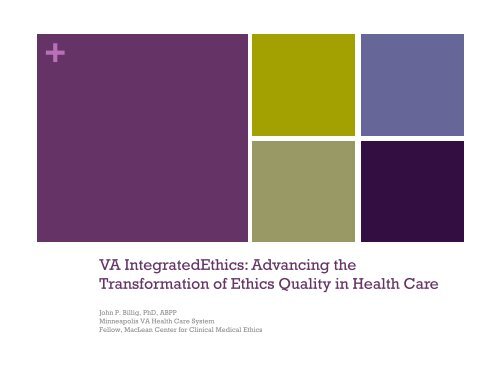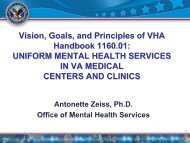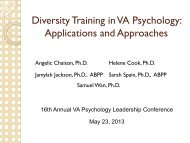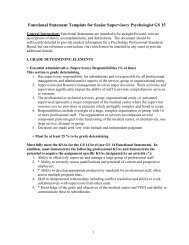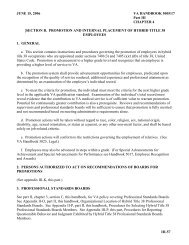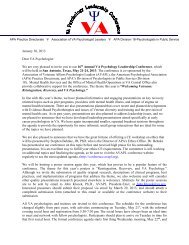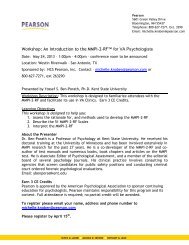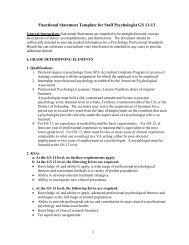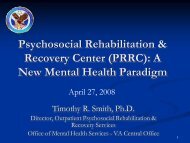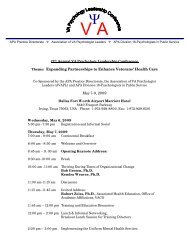Billig--VAPL Ethics Workshop.pdf - Association of VA Psychologist ...
Billig--VAPL Ethics Workshop.pdf - Association of VA Psychologist ...
Billig--VAPL Ethics Workshop.pdf - Association of VA Psychologist ...
- No tags were found...
Create successful ePaper yourself
Turn your PDF publications into a flip-book with our unique Google optimized e-Paper software.
+<strong>VA</strong> Integrated<strong>Ethics</strong>: Advancing theTransformation <strong>of</strong> <strong>Ethics</strong> Quality in Health CareJohn P. <strong>Billig</strong>, PhD, ABPPJohn P. <strong>Billig</strong>, PhD, ABPPMinneapolis <strong>VA</strong> Health Care SystemFellow, MacLean Center for Clinical Medical <strong>Ethics</strong>
+ Disclosures• <strong>VA</strong> Integrated<strong>Ethics</strong>: Advancing the Transformation <strong>of</strong> <strong>Ethics</strong>Quality in Health CareJohn P. <strong>Billig</strong>, PhD, ABPP<strong>VA</strong> Psychology Leadership ConferenceSan Antonio, TX14 March 2012• I have no financial relationships to disclose.• I will not be discussing i any <strong>of</strong>f-label l or investigative use <strong>of</strong>medications or devices.
+ University <strong>of</strong> Chicago and <strong>VA</strong> NationalCenter for <strong>Ethics</strong> in Health Care Fellowship• Program at the MacLean Center for Clinical Medical <strong>Ethics</strong> at theUniversity <strong>of</strong> Chicago• Designed for gaining i training i and experience in medical ethics• Began a partnership with the <strong>VA</strong> in 2010, through which three <strong>VA</strong>medical pr<strong>of</strong>essionals per year are selected through national searchto participate in the fellowship program• Requirements• 5-week full-time summer intensive; then every Wed, Sept-May• Seminars covering a wide range <strong>of</strong> topics, including history, philosophy,biomedical research, law, and religion• Participate in weekly ethics case conference• Monthly consultation with National Center for <strong>Ethics</strong> in Health Care staff toreceive feedback on completed ethics consults
+ Acknowledgementsg• University <strong>of</strong> ChicagoMacLean Center for ClinicalMedical <strong>Ethics</strong>Director:Mark Siegler, M.D.Associate Directors:Peter Angelos, M.D., Ph.D.Lainie Friedman Ross, M.D., Ph.DDaniel Sulmasy, OFM, MD, PhDAssistant Directors:Daniel Brauner, M.D.Ann Dudley Goldblatt, J.D., L.L.M.Tracy Koogler, MDEdward Laumann, Ph.D.William Meadow, M.D., Ph.D.• <strong>VA</strong> National Center for <strong>Ethics</strong>in Health CareEllen Fox, MDChief <strong>Ethics</strong> in Health Care OfficerKenneth Berkowitz, MD, FCCPChief for <strong>Ethics</strong> ConsultationBarbara Chanko, RN, MBAStaff, <strong>Ethics</strong> ConsultationDavid Alfondre, MSPH, MDIntegrated<strong>Ethics</strong> Manager, <strong>Ethics</strong> ConsultationBridgette WileyMedical EthicistJames McAllisterProgram Specialist
+ Acknowledgementsg• Minneapolis <strong>VA</strong> Health CareSystem• Dr. Melissa West, <strong>Ethics</strong>Consultation Coordinator• Steven Kleinglass, Director(retired)• Sue Ricker, Integrated<strong>Ethics</strong>Program Officer• U <strong>of</strong> Chicago/<strong>VA</strong> NCEHCFellows 2011-2012• Dr. Lisa Vig, Seattle <strong>VA</strong>Medical Center• Tiel Keltner, <strong>VA</strong> Central Office• VISN 23• Janet Murphy, NetworkDirector• Sheryl Kittelson,Integrated<strong>Ethics</strong> Point <strong>of</strong>Contact
+ Objectives• Participants will:• 1. Understand historical factors that lead to development <strong>of</strong> thefield <strong>of</strong> health care ethics;• 2. Learn several approaches to ethical reasoning;• 3. Understand Integrated<strong>Ethics</strong>, <strong>VA</strong>’s comprehensive program <strong>of</strong>Health Care <strong>Ethics</strong>.
+ Research with Human Subjects• Nuremburg Code 1947• Resulted from Nuremburg Trials 1945-47• 10 principles for research with human subjects• Voluntary consent essential• Liberty to withdraw
+ History <strong>of</strong> APA’s <strong>Ethics</strong> Code• The American Psychological <strong>Association</strong> began to develop a code<strong>of</strong> Ethical Standards, including issues in human subjects research, in1947• Ethical Standards <strong>of</strong> <strong>Psychologist</strong>s published 1953• 10 th version in 2002, the Ethical Principles <strong>of</strong> <strong>Psychologist</strong>s andCode <strong>of</strong> Conduct• 5 general principles that are aspirational• Beneficence and Nonmaleficence• Fidelity and Responsibility• Integrity• Justice• Respect for People’s Rights and Dignity• Specific ethical standards that are enforceable rules for conductPope & Vasquez (2007). <strong>Ethics</strong> in Psychotherapy and Counseling: A Practical Guide (3 rd Ed.) SanFrancisco, CA: John Wiley & Sons.
+ Research with Human Subjects• World Medical <strong>Association</strong> Declaration <strong>of</strong> Helsinki 1964• Ethical Principles for Medical Research Involving Human Subjects• Proxy consent• Need for IRB review• Amended multiple times through 2000s• US FDA rejected 2000 and subsequent revisionsi
+• Willowbrook hepatitis study 1960s• Institution on Staten Island for children with intellectualdisabilities• Healthy children intentionally inoculated, orally and byinjection, with hepatitis A virus, and monitored to study effect <strong>of</strong>gamma globulin in treating the disease
+• Jewish Chronic Disease Hospital NY 1963• Chronically ill non-cancer pts injected with live human cancercells. Patients not informed so as not to scare them, since it wasbelieved that the cells would be rejected
+• Milgram Obedience Study 1963
+ Research with Human Subjects:Lessons NOT Learned?• Henry Beecher MD “<strong>Ethics</strong> and Clinical Research” NEJM1966• “An experiment is ethical or not at its inception; it does notbecome ethical post hoc - ends do not justify means.”
+ Research with Human Subjects• National Commission for the Protection <strong>of</strong> Human Subjects <strong>of</strong>Biomedical and Behavioral Research• Belmont Report 1979• Three principles to guide research with human subjects:• Respect for persons• Respect for autonomy• Consider best interest <strong>of</strong> those lacking capacity to make decisions• Beneficence• Justice• Application <strong>of</strong> the principles• Informed consent• Assessment <strong>of</strong> risks and benefits• Selection <strong>of</strong> subjects
+ Research with Human Subjects• Title 45 Code <strong>of</strong> Federal Regulations (CFR): Part 46, Protection <strong>of</strong>Human Subjects• 1981, Developed by Department <strong>of</strong> Health and Human Services• 1991, 14 federal government departments join with HHS inadopting a uniform set <strong>of</strong> regulations identical to Subpart A <strong>of</strong> 45CFR 46• The Common Rule• Revised 2005
+• Susan ReverbyPr<strong>of</strong>essor <strong>of</strong> Women’s StudiesWellesley College
+ Guatemala STD Research 1946-48• Reverby studying Tuskegee, investigated Dr. John C. Cutler• Discovered US Public Health Service and NIH sponsored STDinoculation and treatment study in Guatemala• Intentional exposure to syphilis, gonorrhea, and chancroid <strong>of</strong> sexworkers, prisoners, soldiers, and psychiatric patients• Commercial sex workers, intentionally infected with STDs, as wellas “artificial inoculation” methods, were used to transmit disease• Preliminary reports in October 2010• Published: Journal <strong>of</strong> Political History 2011; 23(1): 6-28.• US Secretary <strong>of</strong> State Clinton and HHS Secretary Sebeliusapologized to government and people <strong>of</strong> Guatemala
+ Presidential Commission for theStudy <strong>of</strong> Bioethical Issues• Directive from the President November 2010• Complete historical investigation <strong>of</strong> the STD Research inGuatemala• Provide contemporary assessment <strong>of</strong> what research protectionsare currently in place• Commission i completed two reports• “Ethically Impossible”: STD Research in Guatemala from 1946 to1948 (September 2011)• Moral Science: Protecting Participants in Human SubjectsResearch (December 2011)
+ “Ethically Impossible”: STD Researchin Guatemala from 1946 to 1948• Total subjects: 5540• Intentional Exposure: 1308• 678 <strong>of</strong> whom show some record<strong>of</strong> treatment• Subject age ranges• Intentional exposure: 10-72years• Cutler went on to Tuskegee• Then to University <strong>of</strong> PittsburghSchool <strong>of</strong> Public Health as Deanin 1967• Ethical Conclusions:• Faulty scientific design• Failure to obtain consent,though consent obtained bysame investigators in similarstudy in Terre Haute prison1943-44• Individual investigators can beheld morally culpable• The failures are not justwrong now, but were wrongthen and they should haveknown they were wrong
+ Moral Science: Protecting Participantsin Human Subjects Research• Included InternationalResearch Panel• Conclusion:• Current system providessubstantial protections andserves generally, to protecthuman subjects• Commission found room forimprovement• 14 Recommendations regarding:• Improving accountability• Treating and compensatingfor research-related related injuries• Making ethical underpinnings<strong>of</strong> regulations more explicit• Expanding ethics discourseand education• Respecting equivalentprotections in other countries• Promoting communityengagement• Ensuring ethical study designfor control trials• Promoting current reformefforts
+ Advances in Technology• Control over life and death• Prior to 20 th century, medical practitioners could do little tocontrol disease/death• Development <strong>of</strong> vaccines, antibiotics• Artificial respiration (ventilators)• Kidney dialysis• Transplantation• Implantable devices (e.g., pace-makers, defibrilators)• Reproductive e technology (e.g., in vitro fertilization)
+ Advances in Technology• With increased ability to control or irradicate diseases,prolong life, manipulate beginnings <strong>of</strong> life, multiplequestions are raised:• When and under what circumstances should medicine intervene?Withhold or withdraw intervention? Who decides?• When is someone dead?• How are limited resources distributed?• Questions <strong>of</strong> parentage
+ Civil and Human Rights• Civil rights and racial equality• Student rights• Women’s rights• Patients’ rights• Move from paternalism to shared decision making
+ Approaches to Moral and EthicalReasoning• Top-Down Models• Application <strong>of</strong> Moral Theory• Deductive• Bottom-Up Models• Cases and Analogy• Inductive
+ Examples <strong>of</strong> Moral Theories• Utilitarianism• John Stuart Mill• One ought always to produce the maximal balance <strong>of</strong> positivevalue over disvalue• Do the greatest good for the greatest number• Kantian <strong>Ethics</strong>• Emmanuel Kant• The Categorical Imperative• “I ought never to act except in such a way that I can also willthat my maxim become a universal law.”• One must act to treat every yperson as an end and never as ameans only
+ Bottom-Up Reasoning• Reason from particular examples to general positions orstatements• Casuistry• Case-Based Reasoning• Use case comparison and analogy to reach moral/ethicalconclusions• Paradigm cases• e.g., Tuskegee syphilis studies; Karen Ann Quinlan case;Taras<strong>of</strong>f case
+ Biomedical <strong>Ethics</strong> Principles• Beauchamp & Childress (1977) Principles <strong>of</strong> Biomedical <strong>Ethics</strong>• Sixth Edition in 2009• Four principles:• Autonomy• Beneficence• Nonmaleficence• Justice“Anywhere But New Jersey”
+ Addressing Ethical Concerns inHealth Care Settings• In 1976:• No ethics committees in hospitals• No federal or state court had decided anything about death anddying that clarified the rights <strong>of</strong> patients and their families• Precedent legal cases related to medical decision-makingand death and dying:• Karen Quinlan• Nancy Cruzan• Elizabeth Bouvia• Terri Schiavo
+ Karen Quinlan• 1975, 21 yo comatose from alcohol and barbituates; respirator and feedingtube, parents wanted to disconnect respirator, her wishes unknown, AMAat time equated withdrawal <strong>of</strong> respirator with euthanasia and murder, fear<strong>of</strong> malpractice, no precedent• New Jersey Supreme Court: decision not strictly medical & currentmedical standards need not be determinative• Father asserted daughter’s right to privacy as justification to terminate lifesupport (right to decide personal issues without interference fromgovernment)• Court allowed father to be Karen’s guardian, legal immunity to doctors,suggested ethics committee with advisory role in hospitals• May 1976, Karen weaned <strong>of</strong>f respirator, lived until June 1986• Lead to written advanced directives• 1991, Healthcare Financing Administration (HCFA) requires all hospitals toask incoming patients if they had or wanted advanced directive
+ Nancy Cruzan• January 1983, M<strong>VA</strong>, PVS for 7 years, feeding tube, 3 yearcourt battle by family to remove tube• Hospital required court order to remove tube, probate courtgave approval, Missouri Supreme Court reversed: need for“clear and convincing evidence” standard, US SupremeCourt upheld, case reheard in probate court after moreevidence/testimony• Feeding tube removed Dec 1990, died12 days later
+ Elizabeth Bouvia• 26 yo woman with cerebral palsy, quadriplegia, severe arthritis,competent, completed college, not terminally ill, severe pain,alienated from family and husband• 1983 father drove her from Oregon to California and admittedvoluntarily diagnosed as suicidal, she wanted to be cared for as shestarved to death, was force fed• ACLU assisted her, Dec 1983 court decided to allow forced feeding,lost appeal 1984, finally court ruled “the right <strong>of</strong> a competent adultpatient to refuse medical treatment is a constitutionally guaranteedright which must not be abridged”• She decided to live after winning case, appeared on 60 Minutes in1998 and was still alive in 2002
+ Terri Schiavo• Feb 1990, 26 yo cardiac arrest and hypoxia leading to brain damage,hospitalized in Florida, feeding tube (PEG), dx with PVS, June 1990husband appointed guardian, no advanced directive, husband lives withparents – all involved in her treatment, 1990-1992 1992 moved to variousfacilities seeking rehabilitation and aggressive therapy• 1993 husband and parents beginning to disagree, 1998 husband petitionscourt to remove feeding tube, 2000 court proceedings begin, judge ordersfeeding tube removed, parents appeal through District Court: decisionupheld, feeding tube removed Apr 24, 2001, circuit court judge orderstube reinserted• 2001-2003 fought back and forth between state courts, Gov Jeb Bushsupports parents, Florida Legislature passes “Terri’s Law” allowing Gov toissue a stay in this specific case to prohibit removal, 2004 Florida SupremeCourt declares “Terri’s Law” unconstitutional, Gov Bush files petition to USSupreme Court who refuses a review• March 2005 feeding tube removed, Terri dies 13 days later
+ Ethical Issues in Health Care• End <strong>of</strong> life care• Sanctity <strong>of</strong> life vs. Quality <strong>of</strong> life• Medical futility• Rationing <strong>of</strong> Care• Physician assisted suicide• Coma/Persistent Vegetative State(PVS)• Extraordinary vs. Ordinary Care• Artificial Nutrition and Hydration• Shared decision making• Decision making capacity/competency• Informed consent process• Surrogate decision making/substitutedJudgment• Advance care planning• Limits to patient choice• Privacy and confidentiality• Pr<strong>of</strong>essionalism• Withdrawing treatment and• Conflicts <strong>of</strong> interestforgoing treatment • Difficult patients• Cultural/religious sensitivity
Disclosure• The following slides have been adaptedfrom presentations developed by KennethBerkowitz, MD, FCCP, Barbara Chanko,RN, MBA, and others from the NationalCenter for <strong>Ethics</strong> in Health Care.
• A comprehensive, unified approach topromoting ethical practices in health care• A national education and organizationalchange initiative in the Veterans HealthAdministration (2007-present)
• Integrated<strong>Ethics</strong> was selected as one <strong>of</strong>the “Top 25 Programs” in the 2011Innovations in American GovernmentAward (IAGA) competition conducted bythe Ash Center for DemocraticGovernance and Innovation at the John F.Kennedy School <strong>of</strong> Government <strong>of</strong>Harvard University.
What Is <strong>Ethics</strong>?• <strong>Ethics</strong> is the discipline that considers whatis right or what should be done in the face<strong>of</strong> uncertainty or conflict about values• <strong>Ethics</strong> involves making reflectivejudgments about the optimal decision oraction among ethically justifiable options• http://www.ethics.va.gov/docs/integratedethics/Integrated<strong>Ethics</strong>ImprovingQuality.asx
Health Care <strong>Ethics</strong> in VHA• Shared decision making• Ethical practices in end-<strong>of</strong>-life care• Patient t privacy and safety• Pr<strong>of</strong>essionalism in patient care• Ethical practices in resource allocation• Ethical practices in business and management• Ethical practices in government service• Ethical practices in research• Ethical practices in the everyday workplace
<strong>Ethics</strong> Quality is Associated With:• Improved employee morale• Increased patient satisfaction• Reduced legal liability• Fewer sanctions for ethics violations• More successful accreditation reviews• Better efficiency i and productivityit• Lower utilization <strong>of</strong> inappropriate treatments
Integrated<strong>Ethics</strong>: Closing the GapFrom…To…Isolated pockets <strong>of</strong> ethicsactivityAd hoc, variable processesReactive, case-basedLimited assessment <strong>of</strong>effectivenessComprehensive, organizedprogramSystematic, clear standardsProactive, systems-focusedImprovement-oriented,accountable
Integrated<strong>Ethics</strong> ModelDecisionsand actionsSystems andprocessesEnvironmentand culture
Three Core Functions<strong>Ethics</strong> Consultation• Responding to ethics questions in health care‣ The CASES ApproachPreventive <strong>Ethics</strong>• Addressing ethics quality gaps on a systems level‣ The ISSUES ApproachEthical Leadership• Fostering an ethical environment and culture‣ The Four Compass points
Integrated<strong>Ethics</strong> Infrastructure• Facility– Integrated<strong>Ethics</strong> Program Officer– Integrated<strong>Ethics</strong> Council– <strong>Ethics</strong> consultation, preventive ethics, ethical leadershipcoordinators• VISN/Regional Network– Senior Lead– Point <strong>of</strong> Contact– Integrated<strong>Ethics</strong> Advisory Board• National Center for <strong>Ethics</strong> in Health Care– Integrated<strong>Ethics</strong> Program Staff
Integrated<strong>Ethics</strong> FunctionLeaders• Ethical Leadership Coordinator• Integrated<strong>Ethics</strong> Program Officer• Preventive <strong>Ethics</strong> Coordinator• <strong>Ethics</strong> Consultation Coordinator
Integrated<strong>Ethics</strong> Tools<strong>Ethics</strong> Consultation Preventive <strong>Ethics</strong> Ethical LeadershipReference EC primer PE primer EL primerEasy Reference CASES pocket card ISSUES pocket card Leadership bookmarkAdministrative • Case Consultation • PE log/triage toolSummary• PE meeting minutes• ECWeb• PE storyboard & Summary• Storyboard LibraryVHA Handbook 1004.06, “Integrated<strong>Ethics</strong>”Assessment • <strong>Ethics</strong> Consultant Pr<strong>of</strong>iciency • Ethical LeadershipAssessment toolSelf-Assessment Tool• <strong>Ethics</strong> Consultation FeedbackToolIntegrated<strong>Ethics</strong> Facility WorkbookIntegrated<strong>Ethics</strong> Staff SurveyEducation EC video course PE video course EL video courseEC Beyond the BasicsNew Supervisor & VISN LEADIntegrated<strong>Ethics</strong> Online Learning ModulesCommunications“Improving <strong>Ethics</strong> Quality: Looking Beneath the Surface”“Integrated<strong>Ethics</strong>: Closing the <strong>Ethics</strong> Quality Gap”“Business Case for <strong>Ethics</strong>”, IE in Action
Integrated<strong>Ethics</strong> TechnicalAssistance• Intranet & Internet Sites• Field SharePoint Site• Electronic Newsletter: Integrated<strong>Ethics</strong> inAction• Articles in other <strong>VA</strong> media• IE Improvement Forum Calls
Ethical Leadership• Provides health care leaders with practical toolsand training they need to foster an ethicalenvironment and culture that will helpemployees “do the right thing.”• Organized around 4 Compass Points– Demonstrate that ethics is a priority– Communicate clear expectations for ethical practice– Practice ethical decision making– Support your local ethics program
Preventive <strong>Ethics</strong>• Addresses recurring ethical concerns byapplying quality improvement methods to identifyand address ethics quality gaps on a systemslevel.• The ISSUES Approach– Identify an issue– Study the issue– Select a strategy– Undertake a plan– Evaluate and adjust– Sustain and spread
<strong>Ethics</strong> Consultation• Comprehensive standards, methods, andtools to ensure high quality ethicsconsultations throughout <strong>VA</strong>’s health caresystem.
Goals <strong>of</strong> <strong>Ethics</strong> Consultation• To promote the rights <strong>of</strong> patients• To promote shared decision-making• To promote fair policies and procedures•To oenhance the eethical tenor <strong>of</strong> sa staffand institutions
<strong>Ethics</strong> Consultation• Models– Individual ethics consultant– <strong>Ethics</strong> consultation team– <strong>Ethics</strong> committee• Formal meeting– Level the playing field– Clarify and express values– Create an atmosphere <strong>of</strong> respect56
Types <strong>of</strong> <strong>Ethics</strong> Consultation• <strong>Ethics</strong> case consultation– Discussion and analysis <strong>of</strong> ethical concerns aboutpatient specific circumstances to provide ethicalanalysis, facilitate ethical decision making, andenhance overall quality <strong>of</strong> patient care• Non-case57– Provide information or education– Clarify policy– Review documents– Analyze hypothetical or prior cases– Consider organizational ethics cases
<strong>VA</strong> CASES approach1. Clarify the request2. Assemble the relevant information3. Synthesize the information4. Explain the synthesis5. Support the consultation process
CASES approach• Clarify the request– Is there an ethical concern?– What are the values that t are in conflict?• Pt and/or family values• Clinician/staff values• Hospital policies, laws, etc• What are YOUR values?– What’s the QUESTION?• Given_(uncertainty or conflict about values)_ is it ethicallyjustifiable to ____?• Given_(uncertainty or conflict about values)_ what decisions oractions are ethically justifiable?
CASES approach• Assemble the relevant information– Medical information– Pt preferences and interests– Other parties and preferences– <strong>Ethics</strong> knowledge• Policies, Guidelines, Laws, Literature, etc– Meet with pt and/or family– Talk to involved clinicians– Talk to others (ethics colleagues, lawyers, etc)
4 Box Method – from Jonsen, Siegler,WinsladeMedical IndicationsPatient PreferencesQuality <strong>of</strong> LifeContextual Features
CASES approach• Synthesize y the information– Is a formal meeting needed?– Ethical analysis• What are the different options?• What are the claims and counterclaims?– Identify the ethically appropriate decision-maker– Develop recommendations– Resist the urge to try to FIX everything!
CASES approach• Explain l i the synthesis– Write it up– Communicate the synthesis to key participants– Provide additional resources• Support the consultation process– Follow up– Evaluation <strong>of</strong> the process– Identify underlying systems issues
EC Web
EC Web
Learn more• www.ethics.va.gov/Integrated<strong>Ethics</strong>• vaww.ethics.va.gov/Integrated<strong>Ethics</strong>
Ready for cases?1. Is there an ethical concern?2. What are the conflicting values?3. What’s the ethics question?4. What information is needed?5. What’s your analysis?6. What are your recommendations?
<strong>Ethics</strong> Case ConsultationOxygen Therapy and SmokingA new Chief <strong>of</strong> Respiratory Therapy balks atfollowing an order for home oxygen therapyin a patient who continues to smokecigarettes.He contacts the ethics committee forguidance stating, “I’m not going to beresponsible for blowing up a building full <strong>of</strong>innocent people so some smoker can continue68topuff away!”
C‐A‐S‐E‐S Approach• Clarify the Consultation Request• Assemble the Relevant Information• Synthesize the Information• Explain the Synthesis• Support the Consultation Process69
C‐A‐S‐E‐S Approach• Clarify the Consultation Request– Confirm that the request is appropriate for ethics case consultation• Yes (ethics concern + active patient case)– Obtain preliminary information from the requester– Establish realistic expectations about the consultation process– Formulate the ethics question• Given that the oxygen therapy is medically indicated, butproviding the smoker with oxygen may put him and others atunintended risk, is it ethically justifiable for the provider to denythe order for home oxygen?70
C‐A‐S‐E‐S Approach• Assemble the Relevant Information71– Consider case specific information needed• Learn about home oxygen therapy– Determine the relevant sources <strong>of</strong> information• Patient• Health record / RT / team / safety <strong>of</strong>ficer• Published literature• Similar cases• Applicable policies / rules / laws• Fire department– Gather information systematically from each source– Summarize the case and the ethics question
Assemble Relevant Information• Medical facts– Home oxygen therapy• 6 – 800,000 home oxygen patients in the US• 10 – 30% smoke• Benefits: survival, shortness <strong>of</strong> breath, exercise, cognition, sleep• Risks: local irritation, CO2 retention, fire– Barillo et al: 8/4510– JCAHO: 11 sentinel events 1997‐2001– Fire causes: smoking, cooking (up to 26%), lighting pilot lightsor other’s cigarettes, sparks72
Assemble Relevant Information• Patient / Other’s preferences and interests– Patient– RT• Has a history <strong>of</strong> unsuccessful attempts to stop smoking• Says smoking is the only thing left in his life that he enjoys• Says he will take <strong>of</strong>f the oxygen when he smokes• Prior facility had a rule against smokers receiving oxygen• There is no such policy in this facility, other smokers get O2– Team• The treatment is important and indicated• Statistically, similar patients have improved life expectancy fromat least t20 hours per day <strong>of</strong> oxygen therapy73
Assemble Relevant Information• <strong>Ethics</strong> Knowledge74– Principles• Autonomy, beneficence, non‐maleficence, justice– Precedent cases• 10 – 30% <strong>of</strong> similar patients smoke• Other home oxygen patients in the facility smoke– Values• Provider – patient relationship (limits?)– Laws/policies/regulationsi / l i• No local policies• Coombes v. Florio – the physician is responsible to inform thepatient <strong>of</strong> dangers; the patient is responsible for theconsequences <strong>of</strong> his/her actions
Assemble Relevant Information• <strong>Ethics</strong> question– Given that the oxygen therapy is medically indicated, but providingthe smoker with oxygen may put him and others at unintended risk, isit ethically justifiable for the provider to deny the order for homeoxygen?75
C‐A‐S‐E‐S Approach• Synthesize the Information– Determine whether a formal meeting is necessary– Engage in ethical analysis– Identify the ethically appropriate decision maker– Facilitate moral deliberation among ethicallyjustifiable options76
Synthesize the Information• Ethical analysis– Principlism cp • When does our obligation to provide a therapy(beneficence) and a patient’s right to choose a behavior(autonomy)become less important than our duty toprevent an unsafe situation (non‐maleficence) andprevent danger to others (justice)?• No clear way to prioritize options77
Synthesize the Information• Ethical analysis– Casuistry• When has important therapy been denied on the basis<strong>of</strong> risk to others?– based on clear and imminent danger• Would the prohibition be extended to other behaviors?– e.g., cooking• Logical threads78
C‐A‐S‐E‐S Approach• Synthesize the Information– Determine whether a formal meeting is necessary– Engage in ethical analysis– Identify the ethically appropriate decision maker– Facilitate moral deliberation among ethicallyjustifiable options• Provide the oxygen therapy to this patient in as safe a manner aspossible79
C‐A‐S‐E‐S Approach• Explain the Synthesis80– Communicate the synthesis to key participants• RT / patient / team / safety <strong>of</strong>fice / ?community• Emphasize education and support– Provide additional resources• Articles– Document in the medical record• Progress note– Document in consultation service records• Consider similar cases individually
C‐A‐S‐E‐S Approach• Support the Consultation Process81– Follow up with participants• One month– Evaluate the consultation• RT / patient / team– Adjust the consultation process– Identify underlying systems issues• Possible monitoring• Possible policy development to assure consistency andtransparency
<strong>Ethics</strong> Case ConsultationAlternative Therapy• A 75 y.o. Chinese male is in the MICU on aventilator for advance tuberculosis• He is fed through an NG tube• He is intermittently alert but not able toparticipate in care decisions• His wife only speaks Chinese and hasabdicated her surrogate status to their onlydaughter82
<strong>Ethics</strong> Case ConsultationAlternative Therapy• The daughter, based on the teachings <strong>of</strong> EdgarCayce, wants the patient to receive alternativetherapies for TB– Applewood brandy fumes– A diet <strong>of</strong> ground figs, dates, corn and milk– Olive oil rubs to the chest and back• The attending MD refuses to honor thedaughter’s request• The nurse calls the ethics consultation ti service83
C‐A‐S‐E‐S Approach• Clarify the Consultation Request• Assemble the Relevant Information• Synthesize the Information• Explain the Synthesis• Support the Consultation Process84
C‐A‐S‐E‐S Approach• Clarify the Consultation Request– Confirm that the request is appropriate for ethics case consultation– Obtain preliminary information from the requester– Establish realistic expectations about the consultation process– Formulate the ethics question• Given _(uncertainty or conflict about values)_, what decisions or actionsare ethically justifiable?• Given _(uncertainty or conflict about values)_, is it ethically justifiable to______?85
C‐A‐S‐E‐S Approach• Clarify the Consultation Request– Confirm that the request is appropriate for ethics case consultation– Obtain preliminary information from the requester– Establish realistic expectations about the consultation process– Formulate the ethics question• Given that the patient’s daughter has made a request foralternative therapy that she believes will help her father, but theproviders feel that honoring the requests might compromisepr<strong>of</strong>essional standards, what decisions or actions by the attendingphysician are ethically justifiable?86
C‐A‐S‐E‐S Approach• Assemble the Relevant Information– Consider case specific information needed– Determine the relevant sources <strong>of</strong> information– Gather information systematically from eachsource– Summarize the case and the ethics question87
C‐A‐S‐E‐S Approach• Assemble the Relevant Information– Consider case specific information needed• Learn about Edgar Cayce– Determine the relevant sources <strong>of</strong> information• Patient/family/teamil /• Published literature• Similar cases• Applicable policies/rules/laws– Alternative therapy– Surrogate role/authority– Gather information systematically from each source88 – Summarize the case and the ethics question
Assemble the Relevant Information• Information summary– Medical facts• Patient lacks capacity; critically ill but TB therapy isworking• Dietician does not feel the requested diet will meet the patient’s needs• Diet might clog the tube89– Pt. / others preferences & interests• Patient was not a follower <strong>of</strong> Edgar Cayce• Daughter truly believes in Edgar Cayce’s teachings• Daughter is trying to help her father• Care team is concerned about the patient and their standards– <strong>Ethics</strong> knowledge• Literature does not show efficacy for Cayce’s treatment• No data exists regarding feared risks <strong>of</strong> Cayce’s treatment• Staff are not allowed to administer i patient’s t’ own medications or formulations– Exceptions ‐ herbal teas and Native American practitioners
Assemble the Relevant Information• <strong>Ethics</strong> question– Given that the patient’s daughter has made arequest for alternative therapy, but the providersfeel that honoring the requests might compromisepr<strong>of</strong>essional standards, what decisions or actionsby the attending physician are ethicallyjustifiable?90
C‐A‐S‐E‐S Approach• Synthesize the Information– Determine whether a formal meeting is necessary– Engage in ethical analysis– Identify the ethically appropriate decision maker– Facilitate moral deliberation among ethicallyjustifiable options91
Synthesize the Information• Patient/surrogate can choose from among reasonable healthcare options <strong>of</strong>fered by the team– Basis for surrogate decisions should be understood• Provider is not obligated to provide unreasonable therapiesjust because the patient/surrogate demands them– Support should be provided to the patient/surrogate– Transfer to other providers/sites might be considered92
C‐A‐S‐E‐S Approach• Explain the Synthesis– Communicate the synthesis to key participants– Provide additional resources– Document in the medical record– Document in consultation service records93
C‐A‐S‐E‐S Approach• Support the Consultation Process– Follow up with participants– Evaluate the consultation– Adjust the consultation process– Identify underlying systems issues94
C‐A‐S‐E‐S Approach• Clarify the Consultation Request• Assemble the Relevant Information• Synthesize the Information• Explain the Synthesis• Support the Consultation Process95
Questions?


